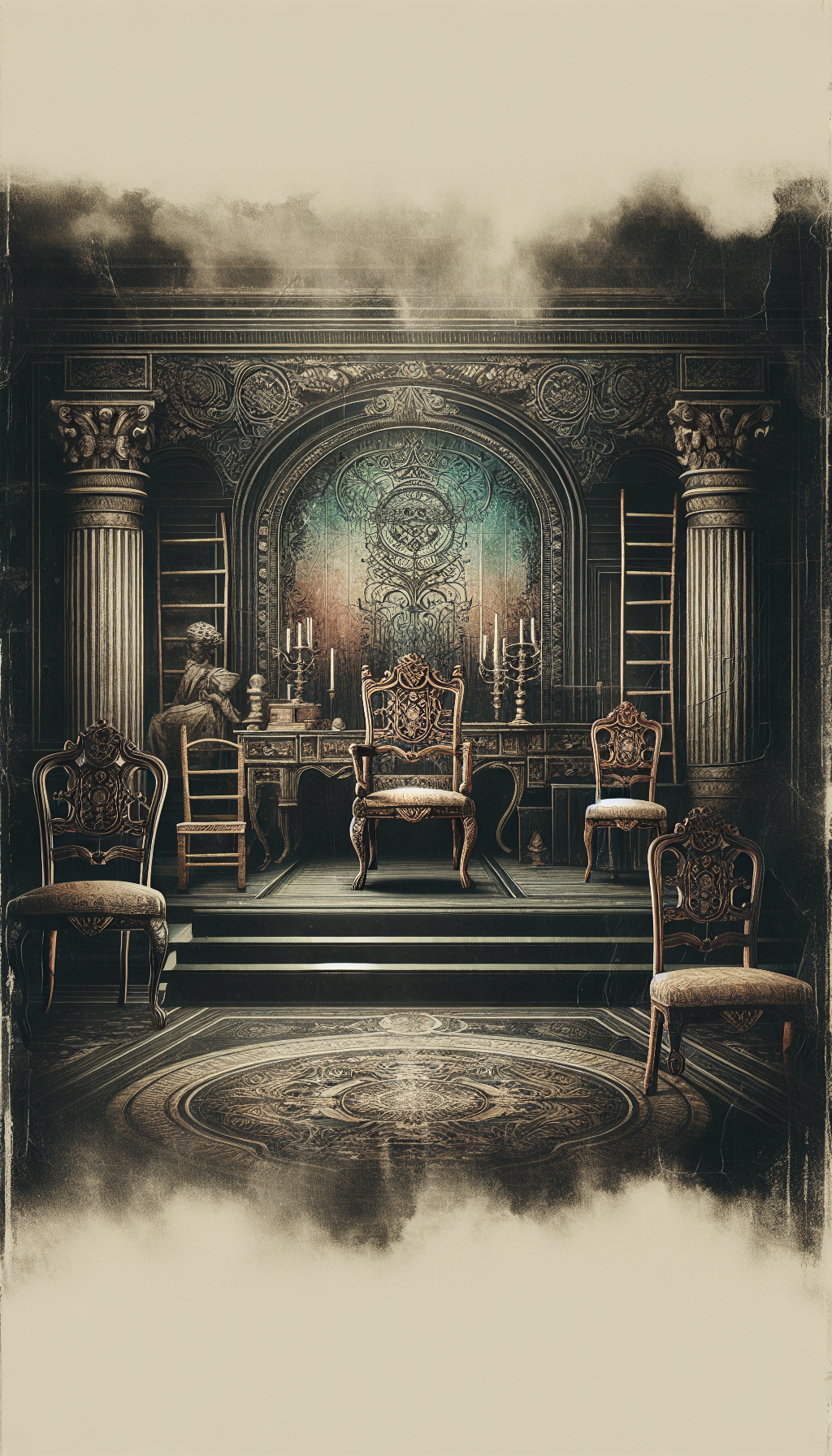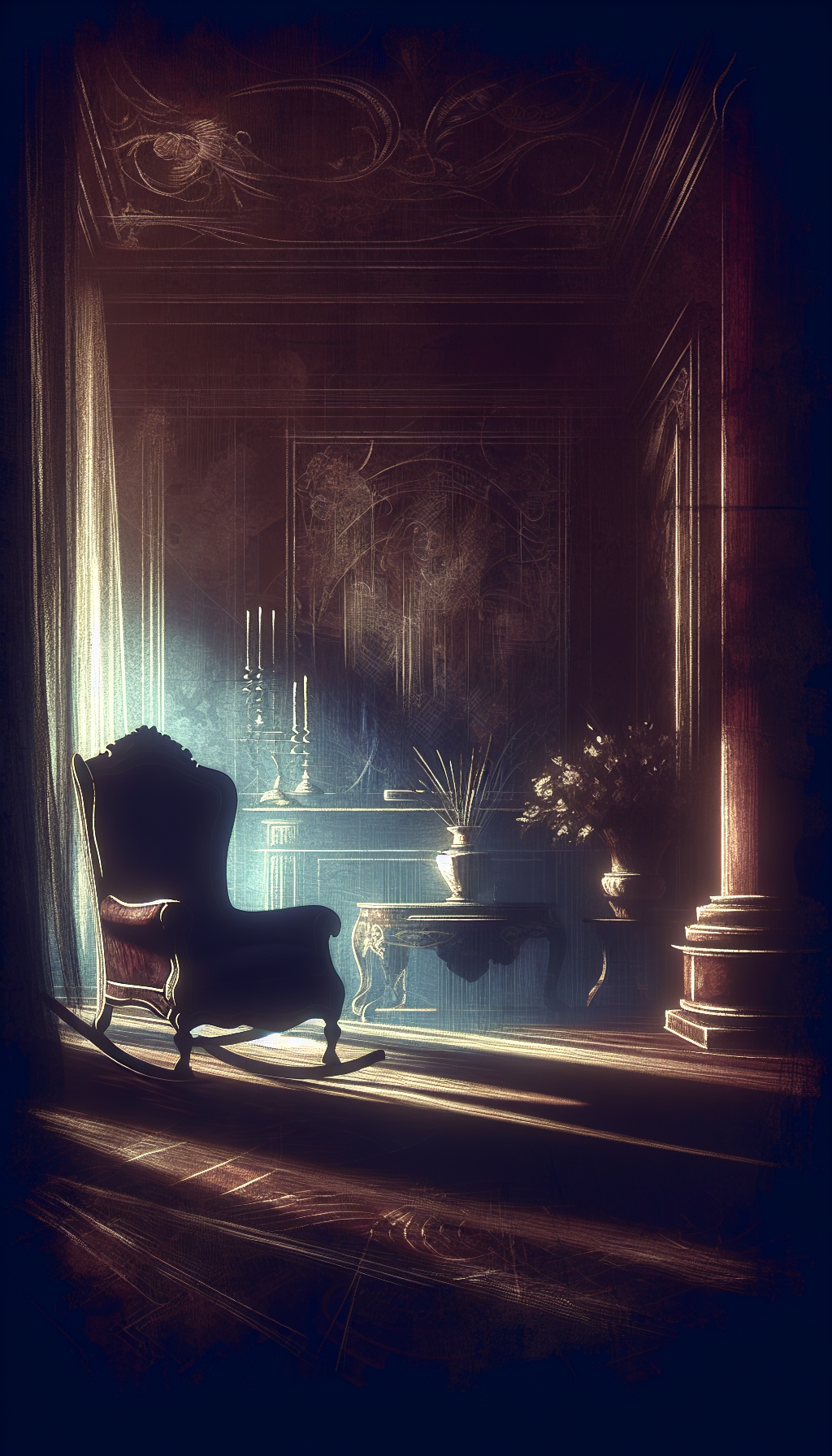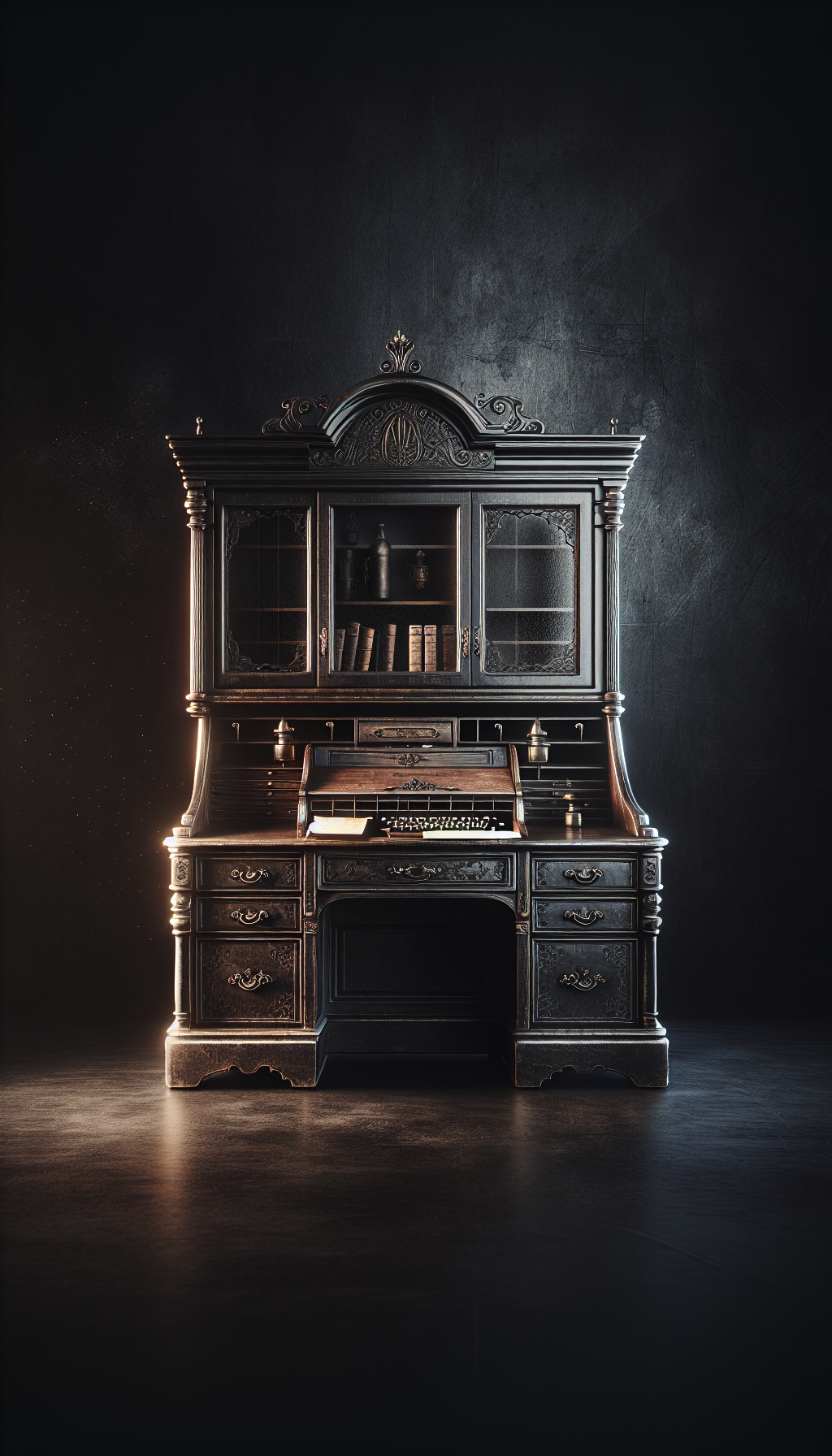A Set Of Furniture In Spanish Barroque Revival Style Circa Early 20th Century
The phrase “Spanish Barroque Revival” (commonly spelled Baroque Revival; in Spanish, Barroco) points to a historicist furnishings style that reinterprets Spain’s 17th–18th century forms for early 20th-century homes. For appraisers and collectors, a complete set from this movement offers both aesthetic cohesion and a fascinating case study in revival-era craftsmanship and market dynamics.
What “Spanish Baroque Revival” Means
Spanish Baroque Revival emerged around 1890–1930, paralleling broader European historicism and, in the Americas, the Spanish Colonial Revival linked to architecture. It borrows liberally from the Habsburg and Bourbon periods—think assertive scale, dark woods, and richly sculptural surfaces—while tempering those traits for modern living rooms and dining rooms of the early 1900s.
Typical vocabulary you’ll encounter:
- Motifs: C- and S-scrolls, acanthus leaves, scallop shells (a Saint James/Santiago reference), mascarons, cartouches, strapwork, and Mudéjar-inspired geometric tooling on leather.
- Structural cues: Block-and-baluster or salomónica (twisted) turnings, hefty trestles and stretchers, arched aprons, heraldic crest rails, and stippled or punchwork grounds behind relief carving.
- Surfaces: Dark-stained walnut or oak, parcel-gilding on carvings, polychrome traces on crests, tooled and studded leather panels (clavos) on chairs and cabinets, and wrought-iron hardware.
The revival is not a direct copy: proportions are often slightly more regular and comfortable, carving more standardized, and finishes aligned with early 20th-century tastes—glossier shellac, sometimes early lacquer.
What Constitutes a “Set” (Salon vs Dining Suites)
In this context, a “set” is a coordinated suite designed, retailed, and often labeled as a group. Common configurations:
- Salon/Living Suite (sala set): A settee or canapé; a pair of armchairs (sillones, including the “sillón frailero” or friar’s chair with leather seat and back); several side chairs; occasional tables; sometimes an escaño (bench) for a hall. Upholstery may be embossed leather with nailheads, tapestry, or mohair.
- Dining Suite: A refectory or bufete trestle table with heavy stretcher base; 6–12 chairs (some with leather backs and seats); a credenza or sideboard with paneled doors and iron strapwork; occasionally a vitrined cabinet or vargueño-on-stand revival writing cabinet to complete the room.
- Hall Ensemble: A carved console with mirror (trumeau), hall bench, and matching wall sconces with wrought-iron arms.
A complete, matching set carries a premium over individually assembled pieces. Look for consistent wood type, carving patterns, moldings, and clavo layouts, as well as matching retailer or workshop labels.
Identification and Dating: Revival vs 17th-Century Originals
Distinguishing early 20th-century revival from 17th–18th-century originals is essential for accurate appraisal.
Indicators of early 20th-century revival:
- Tooling and surfaces: Machine-planed boards; regular circular-saw or band-saw marks; sanding swirls inside carvings; relatively uniform symmetry in paired motifs. Relief carving may be deep but sometimes exhibits repeating patterns indicating mechanical assistance or pattern templates.
- Hardware: Machine-made screws (slotted heads are correct pre-1930; Phillips generally post-1930s). Regular, crisp iron escutcheons and hinges—often cast or stamped rather than hand-forged with varied hammer textures. Wrought-iron look is often achieved with uniform faux hammering.
- Construction: Consistent, tight mortise-and-tenon joinery; occasional use of dowels; panel doors with machine-cut moldings; plywood or veneered secondary panels appear in some American-made “Spanish Renaissance” lines of the 1920s. Chairs often feature coil springs and webbing under upholstered seats (not found in the 1600s).
- Finishes: Shellac (French polish) predominates; by the late 1920s some sprayed nitrocellulose lacquer appears. Look for finish continuity inside hidden areas—original 17th-century pieces are typically unfinished inside; revival sets sometimes show overspray.
- Labels and marks: Country-of-origin stamps (“Spain” or “Made in Spain,” reflecting US tariff laws active from the 1890s onward), paper retailer labels (Barcelona, Valencia, Madrid), branded American maker marks (e.g., Grand Rapids firms marketing “Spanish Renaissance” suites in the 1920s).
Indicators of 17th–18th-century originals:
- Irregular hand-planed surfaces with tear-out; hand-cut dovetails of varying spacing; drawbored mortise-and-tenon joints with pegs; tool chatter in carving; asymmetry between left/right motifs.
- Hardware hand-forged and filed; rosehead nails; evidence of multiple hand-made screws, each slightly different.
- Oxidation and patina: Oxidized, waxy iron surfaces; deep, uneven color build in recesses; oxidized wood under losses; shrinkage causing panel edges to sit proud or recessed.
Revival vs later reproductions: Post-WWII reproductions may use Phillips screws, abundant plywood, and spray-finished stain of uniform color with little patina. Carving can be shallow and repetitive, and leather may be vinyl.
Materials, Construction, and Decorative Techniques
Woods:
- Primary: European walnut (nogal) is the prestige choice; sometimes oak, chestnut, or beech stained dark. American “Spanish” lines used domestic oak, gumwood, and walnut veneers.
- Secondary: Pine, poplar, or softwoods for drawer sides and backboards. Early 20th-century Spanish workshops generally avoided plywood in primary cases, but American factories adopted plywood sides and dust panels by the 1920s.
Joinery and build:
- Chairs: Pegged mortise-and-tenon; trapezoidal seats; H- or X-stretchers, occasionally with turned finials. Seat foundation: webbing and coil springs, with horsehair or fiber fill. Leather seats and backs are tacked with domed clavos in geometric rows.
- Tables: Trestle bases with lyre or baluster supports; through-tenons pegged; carved stretchers with central boss.
- Case pieces: Paneled doors; applied carvings on crest rails; interior of revival vargueños with pigeonholes and small drawers; drop-fronts supported by wrought-iron or brass fall-front supports.
Leather and metalwork:
- Leather: Vegetable-tanned, sometimes embossed or tooled with Mudéjar motifs. Expect oxidation, dryness, and occasional repairs at stress points. Original leather shows irregular pore pattern and edge creasing; later replacements may be too uniform.
- Hardware: Iron strapwork hinges, escutcheons, and corner mounts shaped to evoke 17th-century smithing. Look for continuous black oxidation and wear on high points. Uniform black paint with no wear indicates later replacements.
Finishes:
- Shellac and wax are common; patina accrues as color variation in carvings and edges. Early lacquers may show slight crazing. Overly glossy, evenly colored surfaces suggest recent refinishing.
Stylistic markers specific to the Spanish idiom:
- Estípite pilasters (tapering, faceted supports) on cabinets.
- Salomónica turnings on legs or supports.
- Heraldic shields, scallop shells, and lion masks on crest rails.
- Nailhead patterns forming borders and medallions on leather.
Condition, Restoration, and Value Impact
Typical condition points:
- Joints: Chair racking and loosened stretcher tenons are common; avoid overtightening with screws through legs—a red flag.
- Leather: Dryness, cracking, or ruptured tacking at corners. Conservation can include new hides; retain original leather where structurally sound.
- Wood movement: Shrinkage cracks on panels; acceptable if stable. Filled cracks that interrupt carving can diminish value.
- Insect activity: Old wormholes are common in European walnut; active infestation is indicated by fresh, powdery frass and sharp new holes. Artificial “worming” to simulate age tends to be regular and superficial.
- Hardware and finish: Replaced escutcheons or oversize screw holes indicate changes; heavy sanding softening carvings and edges depresses value. Silicone polishes contaminate surfaces and complicate refinishing.
Restoration guidance:
- Prioritize structure (tight mortise-and-tenons, consolidated chair joints) using reversible adhesives and traditional techniques.
- Replace missing clavos and hardware in style and period; avoid bright new nails—tone replacements to match oxidation.
- Leather: If replacement is necessary, choose vegetable-tanned hides; replicate original nailhead patterns and embossing. Consider saving original backs and replacing only seats to retain more historical fabric.
- Finishes: Clean with mineral spirits and wax; conserve shellac where possible. Avoid aggressive stripping; in-fill local losses with padded shellac, tone with pigments.
Value impact hierarchy (rough, typical weighting):
- Quality of carving and design coherence (high impact)
- Originality of surfaces, leather, and hardware (high)
- Completeness and matching across the set (high)
- Structural integrity (medium-high)
- Provenance and labels (medium)
- Scale and usability for contemporary interiors (medium)
Practical checklist
- Confirm “revival” vs original: check tool marks, hardware, and finishes.
- Verify wood: walnut vs stained beech/oak; examine end grain and weight.
- Inspect labels/stamps: “Made in Spain,” retailer labels, or American maker brands.
- Assess completeness: matching chairs, table, sideboard; uniform carving and clavo patterns.
- Test joints: gentle racking on chairs; look for peg repairs vs screws.
- Evaluate leather: original vs replaced; condition; embossed tooling; clavo alignment.
- Examine stretchers and feet: repairs, replaced parts, and wear patterns.
- Check hardware: iron oxidation continuity; screw type/age; evidence of swaps.
- Review finish: shellac vs modern lacquer; over-sanding; color uniformity.
- Note worm activity: fresh frass vs old, inactive holes; consider conservation needs.
Market Overview and Appraisal Approach
Demand for Spanish Baroque Revival suites rides several trends: the enduring popularity of Spanish Colonial Revival architecture (especially in California and the Southwest), a renewed taste for maximalist interiors, and practical considerations (dining sets with durable leather seats have functional appeal).
Geography and origin:
- Spain: Early 20th-century Barcelona and Valencia workshops supplied high-quality carved walnut suites; labels from retailers and ebanistas add confidence. Granada and Toledo produced ironwork for furniture and accessories.
- Americas: Grand Rapids and other US centers marketed “Spanish Renaissance” lines in the 1920s—high-quality factory production with machine carving and veneer construction. Mexico and the Philippines also produced Hispano-revival furniture, sometimes in local hardwoods; these can be desirable yet typically trade slightly below top Catalan walnut pieces.
Comparables and pricing (general, variable by quality and region):
- Dining suite (table + 8–10 chairs; sometimes sideboard): mid-market carved walnut sets often realize low-to-mid four figures at auction; exceptional, fully documented sets can reach the low five figures.
- Salon suite (settee + 2 armchairs + 2–4 side chairs): typically mid-three to mid-four figures, with premium for original embossed leather, fine carving, and polish.
- Exceptional single forms (vargueño-on-stand revival, monumental sideboard): outliers can command strong prices, especially with provenance.
Appraisal approach:
- Identify the production context (Spanish workshop vs American factory line) and date range (c. 1900–1930).
- Rate carving quality (crispness, depth, undercutting) and design coherence across pieces.
- Inventory components and originality (leather, clavos, hardware, finish).
- Evaluate condition and estimate conservation costs; deduct from market comps to reach fair market value.
- Consider scale and usability: oversize refectory tables or very heavy chairs may narrow the buyer pool.
- Seek provenance: retailer invoices, export stamps, period photographs greatly aid value.
Cautions:
- Beware of mixed sets assembled from similar-looking pieces; minor variations in carving rhythm or stretcher shapes reveal later additions.
- Don’t over-credit wormholed surfaces as “age”—consistent, superficial hole patterns can be distressing rather than historical.
- Distinguish Italian Renaissance Revival (grotesques, lighter walnut, different stretcher forms) from Spanish Baroque Revival; misattribution skews comps.
FAQ
Q: How can I quickly tell if a chair is early 20th-century revival rather than 17th century? A: Flip it over. If you see machine-sawn rails, coil springs tied to webbing, uniform dowels, and slotted screws of consistent manufacture, it’s revival. Originals lack springs, show hand-tool marks, and use hand-forged nails and pegs.
Q: What woods are most desirable for Spanish Baroque Revival sets? A: European walnut is preferred for its carving qualities and historical association. Oak is respectable but usually values slightly lower. American “Spanish” factory lines may use oak or gumwood with veneers; value follows overall quality and design.
Q: Is worm damage a dealbreaker? A: Inactive historic wormholes are common and generally acceptable. Active infestation (fresh frass, sharp new holes) requires treatment and can reduce value until addressed. Artificial “worming” to simulate age is a negative.
Q: Should I replace cracked or dry leather? A: Preserve original embossed or nicely patinated leather when structurally viable. If seat panels fail, period-appropriate vegetable-tanned leather and a faithful clavo pattern preserve both function and value. Document any replacements.
Q: Do labels or retailer marks matter? A: Yes. Country-of-origin stamps, Barcelona/Valencia retailer labels, or American maker brands help date and authenticate a set and can raise value by providing provenance and quality assurance.



